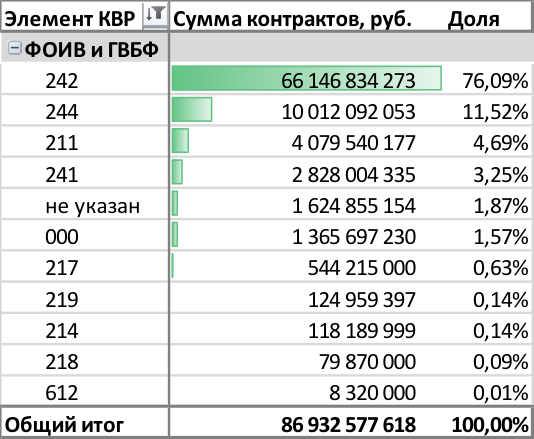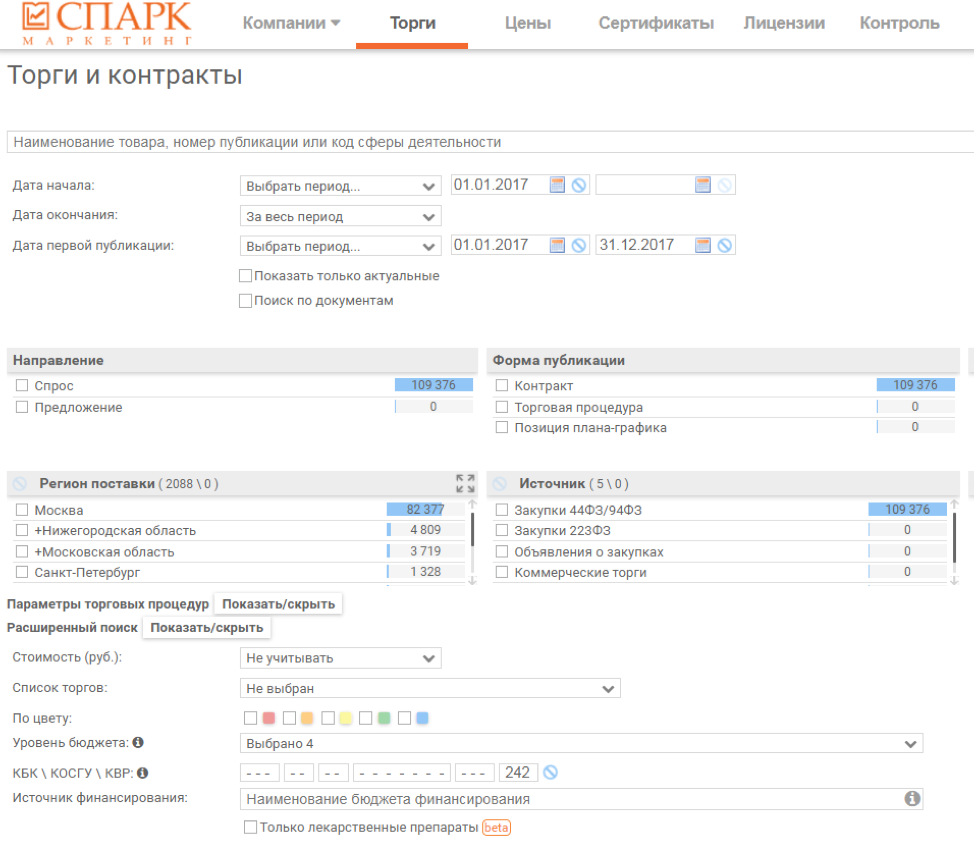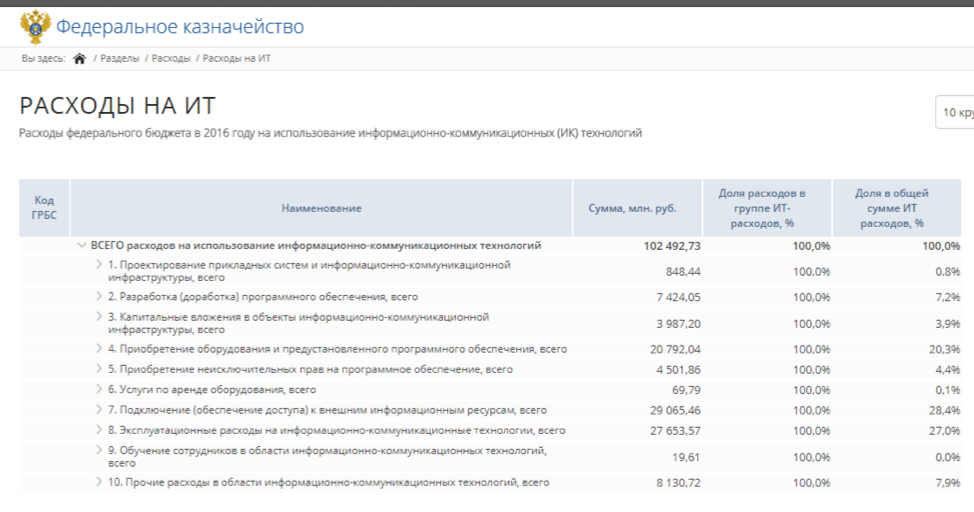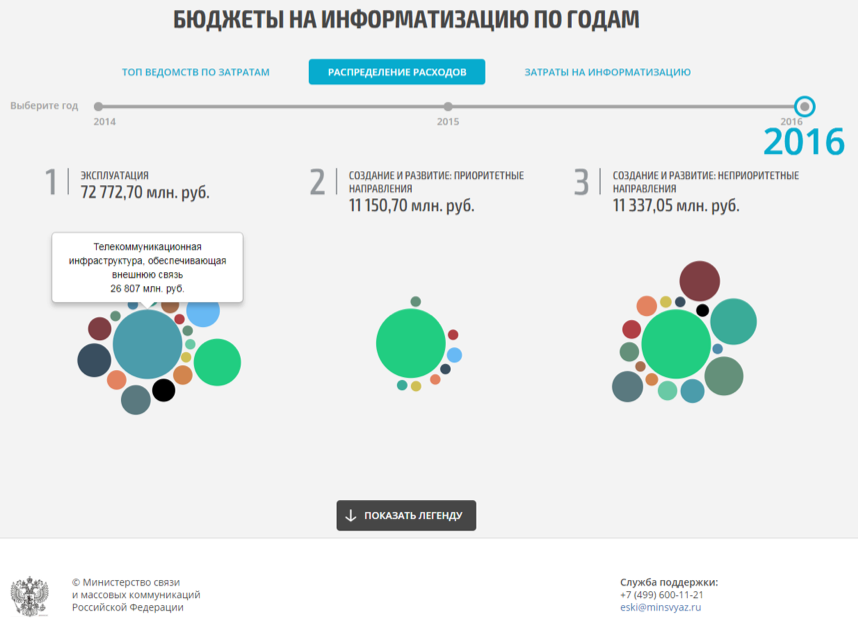The state does not know how much it spends on IT. Proving by numbers
In Russia now there is no single, complete and reliable information about the level of government spending on ICT (information and communication technologies). All that can be found is very contradictory, there is no uniformity of this data.
We, as a company dealing mainly with state structures, are forced to constantly carry out both an analysis of the data we already have and make our own forecasts for the future of government spending on IT, using this data as a base and adding open sources of information to them.
Last week the rating of CNews Analytics Agency “The Largest Suppliers of Solutions for the Public Sector” and the review “ICT in the Public Sector” were released .
')
Let's see what is the real level of government spending on IT in our country.

A sort of “bible” that allows “deciphering” budgets of all levels was the order of the Ministry of Finance on the procedure for applying budget classification, which establishes the principles of appointment, structure, general requirements for the procedure for the formation and application of budget classification codes (BCF) of the Russian Federation, as well as the procedure for assigning codes to composite parts of the budget classification.
Classification of expenditures is a grouping of budget expenditures, which reflects the direction of budgetary funds for the implementation by the authorities of the main functions for solving social and economic tasks.
The budget classification code consists of 20 characters. 20 characters - this is a single classification for the budget system of the Russian Federation. It consists of:

We will not analyze in detail the 17 characters of the classification code, but dwell only on the last 3, that is, the expenditure type codes (CWR). It is they who detail the areas of financial support for government spending on target items.
In total there are 8 large groups of types of expenses, of which the following are related to ICT:
The key element of the type of expenditure, 242 code, is the cost of implementing measures for informatization of the federal budget, federal state bodies, including those under their jurisdiction, federal state official institutions, and governing bodies of state extra-budgetary funds of the Russian Federation.
From January 1, 2017, the procurement identification code (ICZ) shall be indicated in the procurement plan, the notice of procurement, the contract and other documents. This code consists of 36 characters and shows the interrelation of these documents with the budget classification formed using codes, codes of all-Russian classifiers, the catalog of goods, works, services (TRU).
The procedure for the formation of the procurement identification code is established by order of the Ministry of Economic Development and contains the following provisions:
“Software Product” has been monitoring public procurement in the IT sector for many years, so we already have our own approach to this interesting part of the market.
Therefore, in this case, under IT procurement (competitions, tenders), federal executive authorities (federal executive bodies) and state extrabudgetary funds (SCSF) mean tenders that meet the following conditions:
According to the company, the volume of contracts concluded by the federal executive body and the GABF in the field of IT over the past year amounted to 86.9 billion rubles .
Based on the analysis of the identification codes of procurement, the sums of contracts are distributed by elements of the types of expenditure codes:

This shows that:
1. The total number of detected items of expense type codes is 9, 4 of which account for 95.55% of all bidding procedures
2. Line “000” - these are purchases of GBU, GAU, GUP, MUP, as well as purchases of goods, works and services, the expenses for financial support of which are to be reflected by several codes of the type of expenses of budget classification
3. The line “not specified” is the purchase of subordinate institutions in accordance with 223-FZ (ICZ does not apply)
That is, according to our data, only 76% of IT procurement of the federal authorities and the WBG are reflected in the main 242 code element. Taking into account the fact that the entire system of state statistics, budget planning and coordination of informatization operates with 242 elements in order to account for ICT costs, we can draw the following conclusion:
The state does not know how much it spends on IT!
Let us try to estimate the scale of the “under counting” of IT expenditures of the federal authorities and the GCFB.
See a screenshot of the search results from the system SPARK-Marketing criteria:
• Contract publication period - 2017 year
• Date of commencement of the contract - from 01/01/2017
• Source of funding - FB or budget GABF
• Element CWR - 242

The volume of contracts in the system is 109.38 billion rubles.
It is necessary to understand that the functionality of the system allows you to form information only about contracts concluded in the calendar year 2017, while some contracts for the competitions of the year 2017 were concluded in 2018. Such a “transition”, of course, occurs annually, and, therefore, a number of contracts in the SPARK system assigned to 2017 are concluded according to the results of the 2016 competitions. We will assume that the volume of such “transitional” projects is approximately the same from year to year, and we will not take this factor into account in further calculations.
We will assume that the number of purchases not by the 242nd article is unchanged and is about 21 billion rubles. (see table 2), that is, we use our own company data. Then we calculate the maximum share of purchases for article 242. by substituting the Federal Treasury data in the expression ,
Where
- share of expenses for the 242nd CWR element;
- amount of contracts for the 242nd CWR element;
- The total amount of IT contracts.
It is clear that an increase in the volume of IT procurement not for the 242nd article will lead to a “blurring” .
We assume that the percentage of IT procurement in the sample of the company does not change depending on the item of expenditure and is .
Then the real volume of contracts for non-242 article can be estimated as
where
- The estimated level of IT contracts is not for article 242;
- The known volume of IT contracts is not under Article 242.
Then the total amount of real IT costs can be rated as
Where
- the volume of contracts under Article 242 according to FC data;
Based on this, you can evaluate ,
( must be understood as not mathematically, but analytically the minimum possible value of the share of purchases of the federal executive bodies and the WBGF for 242 articles)
That is for the sought The following is true:
"Underestimation" of IT costs can be assessed within the following limits:
The “undercounting” of the expenses of the GVBF and FORIV is in the range from 23.3 to 34.9 billion rubles.
Let's prove it. The data is presented for 2016, and it is during this period that you can find the maximum number of information sources.
According to information from the section “Expenditures of the Federal Budget for IT” of the online data mart of the information and analytical system of the Federal Treasury, in 2016 they amounted to 102.5 billion . Rubles (Budgets for informatization 2016 according to the portal portal.eskigov.ru ).

"FB IT costs". Showcase data IAS FC
According to the portal of the Unified Informatization Coordination System (FGIS KI), “supported” by the Ministry of Communications and Mass Media, the total volume of departmental informatization plans for 2016, including the WBGF, amounted to 95.3 billion rubles .

Budgets for informatization 2016 according to the portal portal.eskigov.ru
According to the annual reports on the execution of the federal budget and the WBG budgets, expenditures for the 242nd CWR element amounted to 107.9 billion rubles for 2016.
We present data on the costs of informatization for 2016 from different sources:

It is obvious that the most comparable, covering the budgets of federal executive bodies and the WBGF, data (FGIS KI and the report on budget execution) differ by 12.6 billion rubles. If we add to the IAS FK data the cash expenses of the GCFB for 242 articles (about 16 billion), then the difference will be +23 billion to the data of FGIS KI and +10.5 billion to the data on budget execution reports.
So let's summarize:
1. The state does not know how much it spends on IT
2. The volume of "shadow" IT costs can be estimated in the range of 23 to 35 billion rubles.
3. Assumptions made as part of the study may introduce an error not exceeding 10-15%
4. The results can be used to assess the real level of government spending on IT.
5. The amount of real IT expenditures of FOIV and GVBF on IT can be estimated at the level of 145 billion rubles.
But!
It should be noted that the government and the relevant ministry are aware of the problem and are taking certain steps to solve it. In particular, on the Federal portal of draft legal acts, the draft government resolution “On measures to ensure the effectiveness of measures to use information and communication technologies in the activities of state bodies” is being discussed.
The project approves a mechanism that allows to include subordinate state institutions in the outline of planning and coordinating activities on informatization and reflecting IT activities contained in government assignments of government agencies in the informatization plans for federal executive bodies.
It is also proposed that research and development work related to the creation (development) of information systems and information and telecommunication infrastructure be attributed to ICT expenditures.
In general, the draft resolution is aimed at a comprehensive solution to the problems of optimizing and increasing the efficiency of the state system for coordinating informatization and ensuring the methodological unity of allocating state funds to the planned expenditures of the federal budget and the budgets of state extra-budgetary funds for the purchase of goods, works and services in the field of information and communication technologies.
At the same time, it should be recalled that in November 2015, Government Decree No. 1235 “On the federal state information system for coordinating informatization” was adopted, which obliged the Ministry of Communications and Mass Media to “bring to mind” the already existing information resources and to form a transparent, public and effective control system for state informatization.
Relevant government contracts were concluded, but to this day the public portal of the system does not provide mandatory information.
We, as a company dealing mainly with state structures, are forced to constantly carry out both an analysis of the data we already have and make our own forecasts for the future of government spending on IT, using this data as a base and adding open sources of information to them.
Last week the rating of CNews Analytics Agency “The Largest Suppliers of Solutions for the Public Sector” and the review “ICT in the Public Sector” were released .
')
Let's see what is the real level of government spending on IT in our country.

Budget classification
A sort of “bible” that allows “deciphering” budgets of all levels was the order of the Ministry of Finance on the procedure for applying budget classification, which establishes the principles of appointment, structure, general requirements for the procedure for the formation and application of budget classification codes (BCF) of the Russian Federation, as well as the procedure for assigning codes to composite parts of the budget classification.
Classification of expenditures is a grouping of budget expenditures, which reflects the direction of budgetary funds for the implementation by the authorities of the main functions for solving social and economic tasks.
The budget classification code consists of 20 characters. 20 characters - this is a single classification for the budget system of the Russian Federation. It consists of:

We will not analyze in detail the 17 characters of the classification code, but dwell only on the last 3, that is, the expenditure type codes (CWR). It is they who detail the areas of financial support for government spending on target items.
In total there are 8 large groups of types of expenses, of which the following are related to ICT:
- 242 - Procurement of goods, works, services in the field of information and communication technologies
- 244 - Other procurement of goods, works and services for state needs
- 414 - Budget investments in state-owned (municipal) property capital construction projects
- 211-219 - Development, purchase and repair of weapons, military and special equipment, industrial-technical products and property
The key element of the type of expenditure, 242 code, is the cost of implementing measures for informatization of the federal budget, federal state bodies, including those under their jurisdiction, federal state official institutions, and governing bodies of state extra-budgetary funds of the Russian Federation.
Classification code
From January 1, 2017, the procurement identification code (ICZ) shall be indicated in the procurement plan, the notice of procurement, the contract and other documents. This code consists of 36 characters and shows the interrelation of these documents with the budget classification formed using codes, codes of all-Russian classifiers, the catalog of goods, works, services (TRU).
The procedure for the formation of the procurement identification code is established by order of the Ministry of Economic Development and contains the following provisions:
- identification code of the purchase corresponds to one purchase (one purchase lot)
- 34-36 IKZ digits indicate the type of expenditure code for the budget classification
- 34-36 IKZ digits indicate “0” in the case of purchases of TRU by a budget / autonomous institution (GBU / GAU) and a state / municipal unitary enterprise (SUE / MUP), as well as in the case of purchases, the expenses for financial support of which are to be reflected for several Expense codes of the budget classification of the Russian Federation
“Software Product” has been monitoring public procurement in the IT sector for many years, so we already have our own approach to this interesting part of the market.
Therefore, in this case, under IT procurement (competitions, tenders), federal executive authorities (federal executive bodies) and state extrabudgetary funds (SCSF) mean tenders that meet the following conditions:
- tender procedures are carried out within the framework of 44- and 223-, the notice of tendering is placed in the Unified Procurement Information System
- classifier code OKPD2 assigned to the lot of purchase satisfies the sphere of business interests
- The initial maximum contract price is at least 2 million rubles.
- tenders for the supply of licenses and equipment - at least 50-70 million rubles.
- purchases of subordinate institutions that carry out regular placement of orders in the interests of the founder (for example, FCI at the CEC, CITT at FCS, IAC support for GAS “Justice” at the Judicial Department, etc.) belong to the corresponding federal executive organization or the GVBF
- purchases of territorial representative offices of FOIV, GVBF and subordinate institutions are not taken into account
According to the company, the volume of contracts concluded by the federal executive body and the GABF in the field of IT over the past year amounted to 86.9 billion rubles .
Based on the analysis of the identification codes of procurement, the sums of contracts are distributed by elements of the types of expenditure codes:

This shows that:
1. The total number of detected items of expense type codes is 9, 4 of which account for 95.55% of all bidding procedures
2. Line “000” - these are purchases of GBU, GAU, GUP, MUP, as well as purchases of goods, works and services, the expenses for financial support of which are to be reflected by several codes of the type of expenses of budget classification
3. The line “not specified” is the purchase of subordinate institutions in accordance with 223-FZ (ICZ does not apply)
That is, according to our data, only 76% of IT procurement of the federal authorities and the WBG are reflected in the main 242 code element. Taking into account the fact that the entire system of state statistics, budget planning and coordination of informatization operates with 242 elements in order to account for ICT costs, we can draw the following conclusion:
The state does not know how much it spends on IT!
Let us try to estimate the scale of the “under counting” of IT expenditures of the federal authorities and the GCFB.
See a screenshot of the search results from the system SPARK-Marketing criteria:
• Contract publication period - 2017 year
• Date of commencement of the contract - from 01/01/2017
• Source of funding - FB or budget GABF
• Element CWR - 242

The volume of contracts in the system is 109.38 billion rubles.
It is necessary to understand that the functionality of the system allows you to form information only about contracts concluded in the calendar year 2017, while some contracts for the competitions of the year 2017 were concluded in 2018. Such a “transition”, of course, occurs annually, and, therefore, a number of contracts in the SPARK system assigned to 2017 are concluded according to the results of the 2016 competitions. We will assume that the volume of such “transitional” projects is approximately the same from year to year, and we will not take this factor into account in further calculations.
We will assume that the number of purchases not by the 242nd article is unchanged and is about 21 billion rubles. (see table 2), that is, we use our own company data. Then we calculate the maximum share of purchases for article 242. by substituting the Federal Treasury data in the expression ,
Where
- share of expenses for the 242nd CWR element;
- amount of contracts for the 242nd CWR element;
- The total amount of IT contracts.
It is clear that an increase in the volume of IT procurement not for the 242nd article will lead to a “blurring” .
We assume that the percentage of IT procurement in the sample of the company does not change depending on the item of expenditure and is .
Then the real volume of contracts for non-242 article can be estimated as
where
- The estimated level of IT contracts is not for article 242;
- The known volume of IT contracts is not under Article 242.
Then the total amount of real IT costs can be rated as
Where
- the volume of contracts under Article 242 according to FC data;
Based on this, you can evaluate ,
( must be understood as not mathematically, but analytically the minimum possible value of the share of purchases of the federal executive bodies and the WBGF for 242 articles)
That is for the sought The following is true:
"Underestimation" of IT costs can be assessed within the following limits:
The “undercounting” of the expenses of the GVBF and FORIV is in the range from 23.3 to 34.9 billion rubles.
Let's prove it. The data is presented for 2016, and it is during this period that you can find the maximum number of information sources.
According to information from the section “Expenditures of the Federal Budget for IT” of the online data mart of the information and analytical system of the Federal Treasury, in 2016 they amounted to 102.5 billion . Rubles (Budgets for informatization 2016 according to the portal portal.eskigov.ru ).

"FB IT costs". Showcase data IAS FC
According to the portal of the Unified Informatization Coordination System (FGIS KI), “supported” by the Ministry of Communications and Mass Media, the total volume of departmental informatization plans for 2016, including the WBGF, amounted to 95.3 billion rubles .

Budgets for informatization 2016 according to the portal portal.eskigov.ru
According to the annual reports on the execution of the federal budget and the WBG budgets, expenditures for the 242nd CWR element amounted to 107.9 billion rubles for 2016.
We present data on the costs of informatization for 2016 from different sources:

It is obvious that the most comparable, covering the budgets of federal executive bodies and the WBGF, data (FGIS KI and the report on budget execution) differ by 12.6 billion rubles. If we add to the IAS FK data the cash expenses of the GCFB for 242 articles (about 16 billion), then the difference will be +23 billion to the data of FGIS KI and +10.5 billion to the data on budget execution reports.
So let's summarize:
1. The state does not know how much it spends on IT
2. The volume of "shadow" IT costs can be estimated in the range of 23 to 35 billion rubles.
3. Assumptions made as part of the study may introduce an error not exceeding 10-15%
4. The results can be used to assess the real level of government spending on IT.
5. The amount of real IT expenditures of FOIV and GVBF on IT can be estimated at the level of 145 billion rubles.
But!
It should be noted that the government and the relevant ministry are aware of the problem and are taking certain steps to solve it. In particular, on the Federal portal of draft legal acts, the draft government resolution “On measures to ensure the effectiveness of measures to use information and communication technologies in the activities of state bodies” is being discussed.
The project approves a mechanism that allows to include subordinate state institutions in the outline of planning and coordinating activities on informatization and reflecting IT activities contained in government assignments of government agencies in the informatization plans for federal executive bodies.
It is also proposed that research and development work related to the creation (development) of information systems and information and telecommunication infrastructure be attributed to ICT expenditures.
In general, the draft resolution is aimed at a comprehensive solution to the problems of optimizing and increasing the efficiency of the state system for coordinating informatization and ensuring the methodological unity of allocating state funds to the planned expenditures of the federal budget and the budgets of state extra-budgetary funds for the purchase of goods, works and services in the field of information and communication technologies.
At the same time, it should be recalled that in November 2015, Government Decree No. 1235 “On the federal state information system for coordinating informatization” was adopted, which obliged the Ministry of Communications and Mass Media to “bring to mind” the already existing information resources and to form a transparent, public and effective control system for state informatization.
Relevant government contracts were concluded, but to this day the public portal of the system does not provide mandatory information.
Source: https://habr.com/ru/post/425081/
All Articles